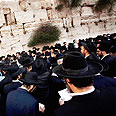
Jerusalem's religious sector growing
Figures released by Jerusalem Institute for Israel Studies reveal national-religious population about to become capital's second biggest sector as haredim search for housing solutions elsewhere
According to figures released by Jerusalem Institute for Israel Studies, since 2003 there has been a 19% increase in the traditional-religious population (36,000 people in 2009), a 15% rise in the national-religious population (54,000) and 14% in the haredi population (78,000).
On the other hand, a 5% drop was recorded in the traditional-non-Jewish population recorded a 5% drop (55,000) and a 10% drop in the secular population (55,000).
An analysis conducted by the Institute pointed to a significant difference in the trends of the Jerusalem population compared to those of the entire country: While Jerusalem recorded a 14% rise in the number of haredim, in all of Israel the growth rate stood at only 5%. And while Jerusalem recorded a 26% rise in the religious population, in all of Israel the growth rate stood at only 16%.
Who studies?
These trends stand out when looking at the number of students in state-religious schools, compared to those studying in state institutions.
More than 250,000 students study in Jerusalem, some 150,000 of them Jewish. The number of haredi students is the highest, standing at 94,000. The state and state-religious education reach 59,000 students together (some 30,000 and 27,000, respectively, and another 2,000 in special education.
For years, the number of children in state kindergartens was higher than in religious kindergartens. This year, for the first time, there is an identical number of children in both sectors – 1,924. An increase has been recorded in the state-religious schools as well.
Religious schools exceeded secular schools in the number of students this year (1,954 in state religions schools compared to 1,801 in secular schools), while six years ago state religious schools had 1,720 students and state schools has 1,841 students.
Although the number of students in the state education has been in decline for more than a decade, the drop rate has been greatly reduced in the past year. In the past three years, seculars have recorded an increase in the number of kindergarten children: From 1,765 more than a decade ago to 1,924 this year.
The ultra-Orthodox education remains the biggest significantly, growing by 25% in the past decade. Today some 94,000 students study in haredi programs.
Haredim leaving
Dr. Maya Choshen, a senior research fellow at the Jerusalem Institute for Israel Studies, believes that the religious population's growth in Jerusalem is an interesting phenomenon.
"The growth increases the city's power of attraction for another religious population, young and educated. I view this as a positive phenomenon, and this is definitely good news for strengthening the city and its workforce. In terms of the seculars, on the other hand, there's a drop – and that's a problem.
"Many people talk about emigration from Jerusalem. Some of this emigration is of haredim who cannot afford the high costs of apartment prices and leave for haredi communities in the outskirts of Jerusalem, like Kiryat Sfer and Beitar Illit, while the religious population continues arriving.
"The data we have also point to positive signs in regards of the growth in the number of young national-religious and non-religious people living in the city."
- Follow Ynetnews on Facebook










